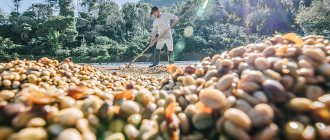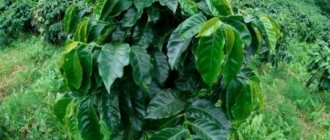To carry out the first coffee harvest, you need to wait until the coffee tree reaches maturity and begins to bloom and bear fruit. Depending on climatic conditions and the botanical type of the coffee tree, maturity occurs in different ways, often 3-4 years after planting in the ground.
In the growing section you can read about all the intricacies of this difficult craft.
Methods of collecting coffee
First of all, it is necessary to list the types of coffee harvesting. There are only a few of them, so it won’t be difficult to figure them out. Regardless of the place of growth, manufacturer and variety, the work is always carried out the same way, and most of the methods appeared hundreds, or even thousands of years ago.
Manual method
It is considered the best option to this day, as it allows for the best quality of the harvest. In addition, hand-picked coffee costs an order of magnitude more. In this case, the labor of hundreds of thousands of workers who are employed every day on the plantations is used. At the same time, there are different collection methods and each has its own characteristic features:
- Stripping. Not the most rational method used to collect commercial varieties. In this case, the worker uses a glove to protect his hand from scratches and damage. You just need to grab the base of the branch, not far from the place where there are berries, and pull to the end, without unclenching your fingers. Due to this, all the fruits are removed - both ripe and not so ripe, and leaves also end up on the bedding material or in the basket.
- Picking. It is used when collecting elite varieties, as it ensures the highest quality of the harvest. In this case, workers remove only ripe berries from the branch, leaving the rest to ripen. Damaged, rotten and overripe specimens are also removed into separate containers. Due to such meticulousness, perfect sorting can be ensured, but the cost in this case is several times higher. Collection volumes using the picking method are much smaller for obvious reasons.
- Fallen berries. Everything that has fallen to the ground is never left there, since pests and spores of various fungal diseases very often overwinter in the fallen berries. Therefore, everything is collected, rotten and unsuitable beans are discarded, and the rest are subsequently added to budget segment coffee. Almost all manufacturers do this.
- Mechanical stripping. This method is similar to classic stripping, but unlike it, it uses not a hand, but a special mechanical device called a derrickider. It resembles a mechanized hand with vibrating sticks, due to which you can pick coffee cherries from several tree branches at the same time.
By the way!
In places with difficult terrain and trees on hillsides, grains can only be collected by hand.
Machine harvesting
This option has been widely used by coffee producers since the 70s of the last century, when special machines were developed for these purposes. Designs vary, but most often it is an assembly of rotating brushes or a vibrating boom, which is attached to the tree trunk through a soft spacer.
Due to the work of brushes or vibration transmitted through the barrel, the grains fall onto a special bedding and are collected. In this case, labor productivity is tens of times higher, but there are also disadvantages:
- The machine collects both ripe and unripe berries.
- Leaves and small twigs fall into the hopper, so you must subsequently sort the crop.
- Trees are inevitably damaged, especially if the equipment is not configured correctly.
This method can only be used on relatively flat plantations where trees are planted at a certain distance. In difficult terrain, the machine method is not applicable. Most often, special equipment is used in Brazil, since there coffee grows on plateaus, and due to the hot summer it ripens almost simultaneously, which reduces the percentage of unripe berries to a minimum.
Labor shortage
It is becoming increasingly difficult for farmers to pay for manual coffee picking; today, the payment of pickers' labor constitutes the bulk of production costs. This is one of the reasons why coffee produced in a developed country, such as Hawaiian Kona, is very expensive. Where the economy is thriving, people don't want to make a living picking berries. Coffee farms in Central America often employ workers who migrate from one country to another, harvesting the crop at different times of the year. Today, most of these pickers are Nicaraguans, because Nicaragua has the weakest economy in the region. In the future, finding workers to harvest the harvest will be even more difficult. At one time, Puerto Rico even used prison labor.
Specifics of collecting different types of coffee
There are many nuances that affect the harvesting of different types of coffee. Therefore, the process can vary greatly. For example, Liberica and Robusta do not fall off the branches even after ripening, so they can be collected later. Most often, producers finish drying the fruits directly on the trees, which not only significantly simplifies pre-processing activities, but also allows them to reduce the cost of coffee.
Arabica beans ripen unevenly, so they are harvested in 3 stages, selecting only ripe berries to ensure the highest quality. There are preliminary, main and late stages. At the same time, it is very important to pick the berries in a timely manner; if they become overripe on the branches, the overall quality of the harvest is significantly reduced.
Fallen berries
Without exception, farmers must collect all the fruits that fall from the tree, whether they are ripe or not. They are kept separately and then mixed with low quality coffee, which happens even with the best farms. You cannot leave fallen berries on the ground under trees. They attract various pests, such as the coffee beetle
Producers who care about the quality of their coffee make sure that pickers pick berries of the same ripeness.
How long does it take for raw coffee to mature?
The process depends on the region of growth and weather conditions in a particular season. Most often, the period is extended and depends on the variety. Robusta and Liberica can dry out after ripening on the tree, but Arabica must be picked on time. At the same time, the ripening process is most often extended over several months and differs in different places on the planet that are traditionally involved in coffee production:
- Brazil - from April to August.
- Java - from May to December.
- In Costa Rica – July-December.
- Guatemala - from August to May.
That is, the deadlines are extended, and after removal it is necessary to carry out certain stages of processing, depending on the technology used on the plantation. In general, from the moment the harvest is harvested until it is shipped to consumers, it takes from two and a half months to a couple of years; this time is spent on the final ripening of the coffee and giving it certain properties that ensure high quality.
Export of coffee beans
The cleaned, sorted and polished beans, now called green coffee, are loaded onto ships in jute or sisal bags loaded into shipping containers, or transported in bulk in plastic-lined containers. According to the USDA, global coffee production is projected to be 169.33 million 60kg bags in 2019/20.
coffee beans
How to determine a good harvest
Producers have their own criteria for determining the quality of the crop that they follow. First of all, the volume of collection of finished products per hectare is taken into account:
- Bad if less than 800 kg were collected.
- Medium, if volumes exceed 800 kg per hectare.
- Good when 1200 kg or a little more is received from Ha.
- Excellent – for volumes of 2000 kg and above.
By the way!
The higher the yield, the larger the beans and the better the conditions in a particular season for the ripening of coffee. Therefore, quality indicators increase by an order of magnitude.
All serious companies have a quality specialist who evaluates the harvest and makes sure that basic requirements are met and that the grains meet certain criteria. This takes into account the homogeneity, quality of the coffee and a number of additional factors.
Drying coffee beans
If the grains have been wet processed, the hulled and fermented grains must be dried to about 11% moisture content to properly prepare them for storage. These grains, still inside the parchment shell (endocarp), can be dried in the sun, spread on drying tables or floors where they are regularly turned, or they can be dried by machine in large drum dryers. The dried beans are known as parchment coffee and are stored in jute or sisal bags until ready for export.
coffee bean processing
Coffee Processing Methods
Harvesting is a small part of the work that coffee producers do. After this, a number of activities are carried out, which depend on the method used for processing. There are 2 main options today.
Dry method
This is a traditional technique, used for many years and worked out to the smallest detail. Its main features are:
- The harvested crop is cleared of debris and all low-quality grains are removed.
- On concrete or other specially adapted sites, coffee is spread in an even layer and dried for up to 5 weeks.
- During the drying process, you need to periodically stir the grains. The duration depends on the air temperature and the number of sunny days.
- After the first stage of drying is completed, the grains are poured into jute bags and kept for at least a few more weeks.
- Peeling is carried out to separate the shell. This is done both manually and using special equipment.
By the way!
This method is best suited for the Robusta variety. It is used mainly by small companies.
Wet method
The technique is an order of magnitude more complicated and is used by large suppliers. In addition, this option allows you to get the highest quality coffee. The process consists of several stages:
- The collected raw materials are cleaned of branches, leaves and other foreign matter.
- They do the washing. This must be done quickly so that the grains do not become saturated with water.
- The pulp is separated from the grains. This is done using special installations called pulpers.
- Pulping allows you to remove most of the shell, but to get rid of the remaining pulp, veins, etc., fermentation is used.
- Fermentation should not last more than 1.5 days, so as not to affect the taste of the future coffee.
- The raw materials must be washed and a special sieve is used to remove any remaining moisture.
- Drying in the sun. The grains are scattered on platforms or racks made of fine mesh.
- During the process of drying in the sun, the coffee beans are periodically tossed. This stage takes about 2 weeks.
Important!
Drying is completed when the moisture content is between 11 and 12%, this is the range that provides the best taste and aroma.
The wet processing method is used for Arabica beans. But even after the process is completed, the beans need to be stored in bags for several months to several years so that the aroma can develop even better. It all depends on the variety and features of the process used by a particular manufacturer.
Coffee is collected using different methods, but the manual option is still the best and allows you to obtain the highest quality products. It is equally important to choose the right harvest time, when the grains have reached optimal maturity. Coffee drying, which is one of the final stages of processing the harvested crop, is carried out both dry and wet. The choice of a specific method depends on the variety and the enterprise producing the product.
Halling
Halling is the process of separating all the excess from the coffee bean so that the resulting product is ready for roasting. This process takes place in special apparatus - hallers, in which parchment and other foreign objects are separated from the grain with the help of air. An important step after halling is manual sorting of coffee, where you need to make sure that there is nothing unnecessary in the bag of coffee, because machines cannot perfectly sort coffee during halling, and there will still be defective beans in the total mass. They need to be removed, because one such grain will completely ruin the cup of coffee it gets into.











